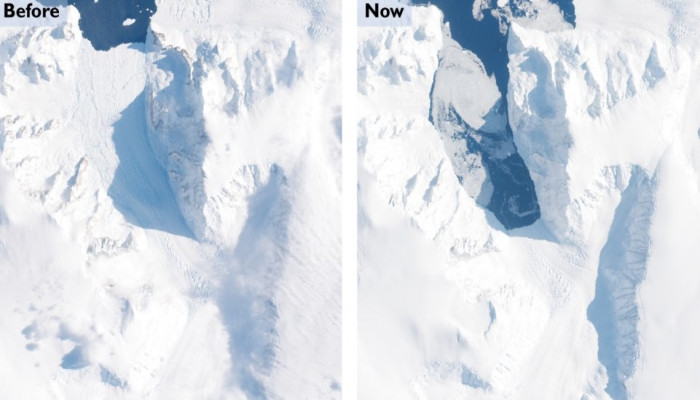Cadman Glacier in Antarctic Peninsula moves 8 kilometres in 2.5 years
- In Reports
- 07:00 PM, Nov 30, 2023
- Myind Staff
According to satellite images from a study led by University of Leeds glaciologist Benjamin Wallis, Cadman Glacier on the west Antarctic Peninsula has shifted 8 kilometers in just two-and-a-half years. The study, conducted between November 2018 and May 2021, revealed the glacier's retreat as its ice shelf at the end collapsed.
Scientists warn that Antarctic glaciers may experience rapid transformations, leading to substantial ice loss due to warmer ocean conditions. The collapsed ice shelf, had it remained intact, could have impeded the glacier's movement towards the sea. Warmer ocean waters are thought to have enveloped the glacier, resulting in the thinning and ungrounding of the ice shelf.
As a result, the glacier's flow speed doubled, causing a rise in ice discharge into the sea through the process of iceberg calving. Benjamin Wallis expressed surprise at the rapid deterioration of Cadman Glacier, stating, "We were surprised to see the speed at which Cadman went from being an apparently stable glacier to one where we see sudden deterioration and significant ice loss."
Wallis highlights the unique response of neighboring glaciers, providing valuable insights for anticipating climate change impacts in the polar region. The Cadman Glacier is currently experiencing a "substantial dynamic imbalance," with ice elevation decreasing at a rate of about 20 meters per year.
An estimated 2.16 billion tonnes of ice are flowing into the ocean annually. Emphasizing the significance of long-term monitoring, the researchers integrated three decades of data from nine satellite missions and in-situ oceanographic measurements.
The study, titled "Ocean Warming Drives Rapid Dynamic Activation of marine-terminating Glacier on the West Antarctic Peninsula," was published in the scientific journal Nature Communications on November 28. The instability of the Cadman Glacier is linked to exceptionally high ocean temperatures in 2018/19, leading to a gradual thinning of the ice shelf since the early 2000s.
Researchers found that certain neighbouring glaciers remained stable due to subsea ridges serving as a defense, redirecting warmer water channels. However, scientists caution that increasing ocean temperatures may compromise the protective capacity of these ridges.
Image source: Wion







Comments